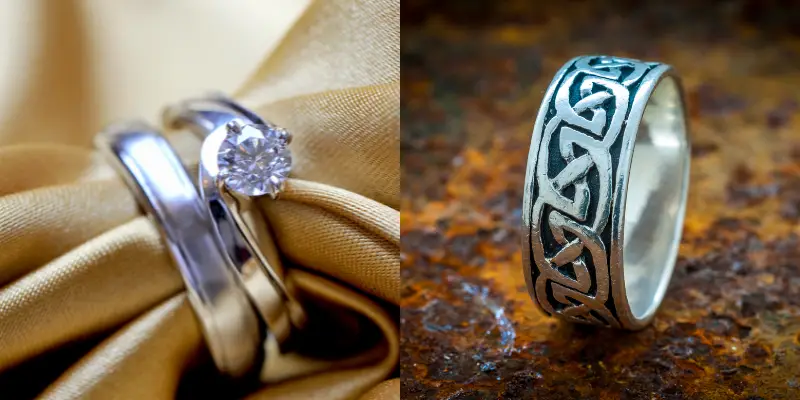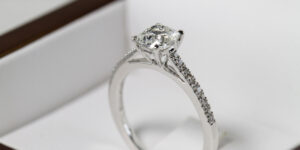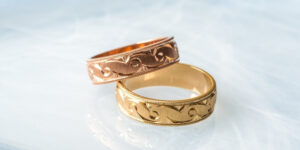When it comes to jewelry colors one of the biggest discussions is what metal you should get, if you want a white metal. Most people won’t opt for platinum since it’s the heavier, more expensive upgrade. Most people look at silver and white gold, and try to weigh the pros and cons as best they can. Well we’ve been in that exact situation, as we wanted white metal for our wedding bands, and here’s the logic we used. We hope it will come in handy for you too.

White gold vs silver
White gold ends up looking whiter, brighter, shinier than silver and does not tarnish in time. Silver does tarnish and requires regular upkeep, and needs professional cleaning every couple of years. Silver also tends to be softer than white gold, so in the long run it will wear down quicker. White gold is more expensive than silver, at least double the price, so it works better if you’re on a budget.
Both silver and white gold have their uses in jewelry, and in the end the decision is completely personal. Here’s a more detailed explanation of what each of these metals is, and how they compare to one another.
What is white gold ?
In jewelry white gold is a metal alloy meant to obtain a whiter, lighter color gold than the standard yellow gold. Most commonly you’ll find jewelry gold in 10k, 14k, and 18k. Pure gold (24k) is far too soft to be used for anything, so it is alloyed with tougher metals to be worn in jewelry. For white gold, the alloy consists of pure 24k yellow gold and nickel/zinc/silver/palladium, in the following proportions:
- 10k white gold – 41,7% pure gold, 47.4% silver, 10% palladium, 0.9% zinc
- 14k white gold – 58% pure gold, 42% silver and nickel alloy
- 18k white gold – 75% pure gold, 25% nickel and zinc alloy
The more pure gold present in the white gold alloy, the softer the alloy, hence why some versions use more nickel or zinc instead of silver. Not all goldsmiths and jewelers use the same formulation, since there are several ways to obtain different shades and strengths of white gold.
Also the more pure gold in white gold, the warmer the color. White gold’s true color is not white, but rather a very pale yellow, or creamy off-white. Lower karat like 10k white gold is whiter, since it has less yellow gold in it than the higher karat 18k white gold. All white gold is rhodium-plated, unless you specifically ask for it not to be. This plating wears off in time and needs to be re-applied.
What is silver ?
Silver in jewelry is most commonly sterling silver, which is a metal alloy made of 92.5% pure silver and 7.5% copper. The addition of copper makes silver tougher, and allows it to be used in most jewelry.
Silver is far more common in jewelry than white gold, but it’s usually reserved for casual jewelry. There is no guarantee that the silver jewelry you buy is always sterling silver, but it’s the most common silver alloy on the market. You can identify it by the 925 stamp.
White gold is whiter than silver
When you decide what jewelry you want, you’re also thinking colors. Some people do not want to wear yellow or rose gold and instead want to opt for white metal. But in some cases the silver can be too gray or dull, so people turn to white gold. Of course, they are turning the the rhodium plating on white gold since white gold itself is not white.
But the overall effect is that a white gold wedding band will be a bright, shiny white while the silver wedding band will be a light gray, less shiny. For us this difference mattered and we decided to get 14k white gold bands, with a rhodium plating.
You might be wondering if you can get a rhodium plating on your silver ring. You can, it’s just very expensive, to the point where you’re better off buying a white gold ring that’s already plated. Rhodium plating is pretty expensive, and it’s one of the reasons it’s done in such a thin layer.
Read also: Diamond Girdle Meaning & How To Protect It
Silver will tarnish faster, white gold does not
Silver is one of the metals that tarnishes, and needs regular upkeep. If you’ve got jewelry with an intricate design, such as a filigree ring, cleaning the silver and polishing it is not easy since you can’t easily get into every nook and cranny. Still, with regular upkeep, a soft toothbrush, and some toothpaste you can keep it looking decent. For a deep cleaning you will need a jeweler or goldsmith.
White gold does not tarnish, partly due to its rhodium plating (100% tarnish resistant) and partly due to its gold content (also 100% tarnish resistant). What may tarnish is any trace amount of silver or copper within the alloy, if your alloy has that. But this is minimal and happens over several years.
So in short, white gold, plated or not, doesn’t need regular upkeep like sterling silver since it won’t tarnish. If you’d like a hassle-free ring, then white gold is the better choice here.
White gold is a bit tougher than silver
Both silver and white gold can and will scratch, and even bend if you insist, but white gold ends up tougher than silver. If you wear two rings together, white gold and silver, the white gold will hold up better in time and even eat into the silver if you wear them side by side.
The downside to this is that while silver can be re-polished into a gleaming, shiny new look white gold is more difficult. It needs its rhodium coating stripped, the gold polished, and the rhodium re-applied.
Still, most of the scratches on white gold will usually be present on the underside of the ring, since that is the one touching various objects throughout the day. If you’re like most people (and us), a little patina on the underside won’t matter much.
Some silver may leave a green mark on your skin
Not all people have a copper allergy, but if you’re extra sensitive to copper your silver ring may give you a green/black mark on the skin. This can be avoided if the alloy doesn’t have copper and instead has another element, such as palladium or platinum for example. These are exceedingly rare silver alloys but if you ask for a hypo-allergenic silver alloy we’re sure the goldsmith can provide.
Again, not everyone has the misfortune of getting a skin reaction form sterling silver. But if you do, you can get a different silver alloy or get a white gold ring with rhodium plating.
White gold jewelry tends to be more expensive than silver
There is also a price difference between white gold and silver, in part due to how heavy the jewelry is and also due the the price for gold and silver. In general pure gold is about twice the price of pure silver. Pair that with gold being twice as dense as silver, you’ve got a white gold ring that will be heavier and more expensive than the same ring made of silver.
The usual price difference between silver and gold jewelry (any gold at all) is 100% more expensive. So if a silver filigree band would weigh 3 grams on size 5 and sell for $19, then the same band in the same size would weigh more if done in yellow gold (about 4.8 grams) and cost roughly $40. If you add a rhodium plating it can easily get to $50.
This was just an example to give you a general guideline on the price differences. The actual price differences may vary from goldsmith to goldsmith, and some retailers may have special offers on some metals.
Be very careful when reading the jewelry description ! There’s a big difference between solid silver and silver plated items ! If it’s very cheap it’s likely not solid silver.

I’m the main author for jewelrymaterialguide.com. I started this site after we did tons of research before our wedding and noticed that there is information about rings, jewelry, and so on that is really hard to find on the internet.






